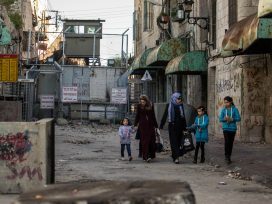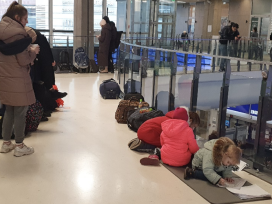More than half a million Afghans were displaced in 2021, adding to many more forced to flee over decades of uninterrupted violence. But offers to accommodate Afghanistan’s ‘living dead’ are often conditional on obscure definitions of neediness.
As a post-colonial society emerging from protracted conflict, Afghanistan confronts a complex legacy of political crimes and widespread violence. Communist rulers, Soviet occupiers, rural resistance fighters, Islamist parties, the Taliban, al-Qaeda, power-seeking warlords and the anti-Taliban coalition have all contributed to the litany of abuses across the country since 1978. There have been multiple waves of exodus as a result. Almost no one in the Afghan society has been left untouched, and almost no one with any power has clean hands.
Several decades of conflict in Afghanistan have taken the lives of more than a million people. The country and its people have suffered the gravest violations of rights and there is a strong desire for justice.1 But after the fall of the Taliban in 2001, the transitional government with its base of international support ignored calls to deal with the crimes of the past. This failure threatens the legitimacy and foundation of institutions both new and old.
Society and the state must begin by conducting comprehensive national consultations and developing a transitional justice strategy that is coherent, multi-dimensional and based on negotiations with different sectors of the public. Unfortunately, identification of victims and the ways they have been subjected to mass political violence easily turns into a numbers game. Creating a tally of the dispossessed and the displaced is even more difficult. Who counts and who is counted are both problem-laden issues.
Under these circumstances, critically evaluating how the ‘local’ is consulted in post-conflict efforts toward reconciliation is of utmost importance. There is a tendency in transitional justice efforts to contain the discussion of the local within the religious and cultural parameters in the Global South, thus engaging only with a ‘static local’, as interpreted by certain local stakeholders.2
Instead, we must pay attention to a ‘dynamic local’ where societal norms evolve. Here, realities on the ground are shaped by shifting power dynamics, local hierarchies and inequalities between actors, as well as histories of statehood. The local must be understood as an inter-subjective concept, whose meaning is dependent on who is consulted to construct and interpret it. This brings us to the issue of the displaced and the dispossessed.
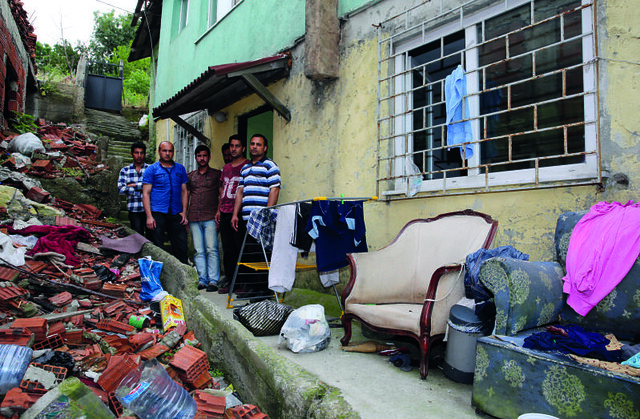
In Beykoz, Küçüksu, the ‘illegal labour market’ with hundreds of Afghan refugees looking for livelihood is set up at the first light of the day.
Photo via Beykozguncel.com
Histories of human suffering
In Afghanistan, developing transitional justice mechanisms may be the only way for the future of the society to hold promise. Reconciliation has long been promoted as a nation-building strategy. However, the implementation of transitional justice measures in the Afghan context poses distinct challenges. First, it entails reconciliation among competing armed groups and ethnic identities. This assumes that the causes of past conflicts run along ethnic lines, which limits individual accountability for war crimes.
Transitional justice also considers violence and crimes of war as things of the past, ignoring the present situation. Given the long history of war between the US-led forces and the Taliban, and current insecurity and escalating levels of violence, it is also doubtful whether transitional justice can take place during an ongoing war-like situation.
Over at least forty years of conflict, the people of Afghanistan have witnessed disappearances, torture, mass executions, civil conflict, internal displacement and forced mass migration to Pakistan, Iran, Turkey and other countries. Almost every Afghan has a personal story to tell of struggle, suffering, survival and loss. Yet, despite the scale and length of the violence, there has been no accountability for past crimes in any phase of ongoing warfare. Since the signing of the Bonn Agreement in 2001, no concerted efforts have been made by the Government of Afghanistan to implement a process of transitional justice.
Instead, the victims see former perpetrators of human rights violations in government, in their communities and on television. Afghanistan’s victims remain largely unacknowledged by the government, although civil society organisations have expressed support for an official process to commemorate them. Ignoring suffering and grievances will ultimately have long-term consequences. In Afghanistan, there is growing evidence that impunity and lack of faith in justice institutions act as drivers of repeated insurgencies.
Afghanistan has both a national Action Plan for Peace, Reconciliation and Justice (2005) and a Law on National Reconciliation, Public Amnesty and National Stability (2007). To date, however, the Action Plan has not been implemented. Furthermore, although it rejected blanket amnesty, it failed to serve as a safeguard against the passing of the Amnesty Law by Afghanistan’s National Assembly in 2007. This served as a clear signal of the continuing power of alleged human rights violators.
The law prior to the current Taliban regime upheld the right of people to bring charges against individuals in court. However, in the absence of a complaint by a victim, Afghan authorities were prohibited from prosecuting accused war criminals. This allows the government to deflect its responsibility for investigating and prosecuting perpetrators.
Life as death
The concept of ‘Necropolitics’ – the idea of the liminal space occupied by those experiencing ‘death-in-life’ – puts our understanding of the power to ‘let die’ into sharp relief.3 ‘To let die’ is to deprive individuals of access to the necessities to live with decency. During the Afghan exodus, death, poverty and precarity have been normalized as choices made by individuals, rather than shaped by the political context and systemic and historic conditions. Individuals are forced to experience their ordinary living as ‘like-death’, where there is no viable escape.
Both the causes of their predicament and the solutions to it remain obscure. Worse still, the impact is always inter-generational. This makes the experience of living death one of the cruellest forms of structural violence. The displaced are not only more likely to suffer, they are also much less likely to have their suffering noticed. Overlooking historical inequality, precarity and perpetual suffering leads to the normalization of exodus.
Neoliberal biopolitics marketizes access to means of survival. If individuals are unable to compete effectively, for example by failing to register themselves with the right kind of refugee admission agency, or due to chronic illness, to the presence of young children or pregnant women, or to the inability to assess risk while they undertake perilous journeys, they are faced with consequences that are in turn perceived as their ‘inevitable’ predicament. The individual is held responsible for ‘failing’ to ensure their own survival, not the political, economic or social system that produces the conditions framing their lives.
The invisibility and/or normalization of mass human suffering, and the resilience, struggles and resistance of the Afghan people deserve much more attention. The combination of ‘break’ and ‘continuity’ that characterizes Afghanistan’s history reappears in the current situation, which is marked by uneasy alliances and the unparalleled militarization. The current ‘interregnum’ urgently needs to be understood not in the language of endless crisis but in the alternative language of ‘Afghan futures’.
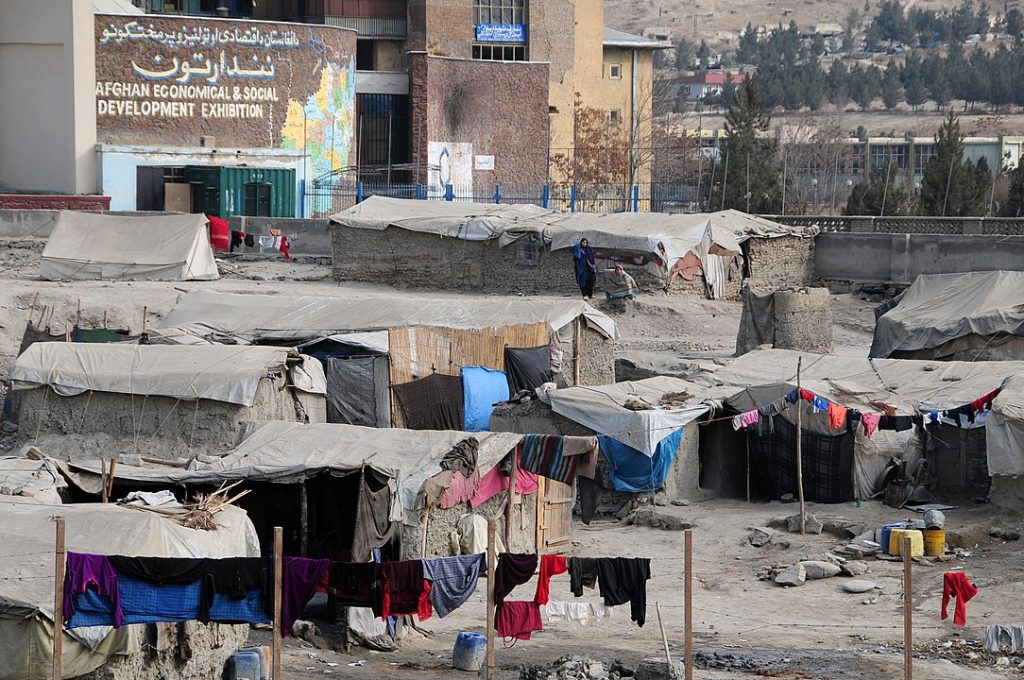
An overall view of a refugee camp in Kabul Photo by NATO Training Mission-Afghanistan, CC BY-SA 2.0 via Wikimedia Commons
Geographies of displacement
The latest wave of brutality in Afghanistan has forced more than half a million people from their homes in Afghanistan in 2021.4 Thousands more are trying to escape. An estimated 2.2 million Afghan refugees now live in neighbouring countries, while around 3.4 million people have become internally displaced over the past forty years. Women and children make up 80 per cent of Afghanistan’s refugees and displaced people. Alongside homelessness and the permanent threat of myriad forms of gendered violence, they face drought, famine, pandemic and a health system at breaking point.
More than 123,000 civilians were evacuated by US forces and its coalition partners after the Taliban took control of the Kabul on 14 August. But it was unclear exactly how many of those were Afghan nationals. The US government declared that of the nearly 80,000 civilians it flew out of the capital, more than 73,500 were either Afghans or other foreign nationals. The UK Ministry of Defence declared it had flown out more than 15,000 people, of whom 8,000 were Afghans. As many as 300,000 Afghans have been affiliated with US operations in the country since 2001, according to the figured provided by the International Rescue Committee, and tens of thousands of them are eligible to obtain a US visa based on the curious category of ‘humanitarian parole’.
But many will now have to find a different way out of the country in order to benefit from that ‘exceptional status’. The US government stated that it had received assurances from the Taliban that Afghan nationals with valid travel documents would be allowed to leave Afghanistan. The question is whether exodus offers a new life or is simply a means of survival.
The Taliban control all the main land crossing points with Afghanistan’s neighbours. Traders or those with valid travel documents may cross those checkpoints, yet the majority will not have any paperwork. Uzbekistan said it would help transfer Afghans to third countries but would only host refugees temporarily. Tajikistan offered to accept up to 100,000 refugees but it is unclear if any have been allowed in yet. Turkmenistan has made no commitments to take in refugees.
Pakistan, which has the longest border with Afghanistan, has stated that it would not accept refugees since it is already overburdened. Afghans in Pakistan (known as the Muhajreen) are considered citizens of Afghanistan, despite most having been born in Pakistan after the first refugee wave in 1979, following the start of the first Soviet-Afghan war. Ethnically, Afghan refugees in Pakistan are Pashtuns, followed by Tajiks, Hazaras, Uzbeks, Baloch and Turkmen. Although most of the four million Muhajreen returned to Afghanistan after 2002, an estimated 1.5 million remain, the majority in the Pashtun-majority province of Khyber Pakhtunkwa and Balochistan. Many are supported by family members settled elsewhere as refugees and migrants.
Iran has also stated that it cannot cope with a further influx. Iran has no interest in accepting more ‘living-dead’ from Sunni-majority Afghanistan in exchange for a Taliban promise not to kill any of the country’s Shias. Afghan Shia populations would likely be the only ones who are allowed to flow into Iran. Many Afghans pay a human trafficker on the Afghan-Pakistan border to get into Iran. From here they try to reach Turkey, where they seek asylum and family reunion with their wives and children.
The Turkish government has urged European countries to take responsibility for the new migrant crisis, announcing that Turkey would not be ‘Europe’s migrant storage unit’. Despite being separated from Afghanistan by Iran and a perilous 2,000-kilometer journey, Turkey already hosts more than half a million Afghans, alongside 3.6 million Syrians. Legal processing of Afghans once they are inside the country allows them temporary protection.
However, Ankara is fortifying a three-meter-high wall along part of its 560-km border with Iran, which it started building in 2017. The plan is to extend the barrier from around 155 kms to 242 kms, and supplement it with deep ditches, razor wires, thermal cameras and additional troops. Turkish interior minister Suleyman Soylu recently claimed that Turkey had blocked the entry of 1.25 million illegal immigrants over the past three years. Since 2016, Ankara had caught 400,000 Afghans, 151,000 of whom had been returned to their country by air. He added that 80,000 had received international protection and stayed in Turkey, another 20,000 had received a residence permit, while the rest had left the country illegally.
Then comes India, which has been involved in ‘rebuilding Afghanistan’ over the past two decades and already hosts more than 15,000 Afghan refugees, dating back to the Soviet-Afghan war. As of early 2021, a total of 41,315 refugees and asylum-seekers were registered with the UNHCR India, with Afghans making up the second-largest subgroup. New Delhi stated that it would help Afghanistan’s minority Hindus and to come to India – but will they be part of Indian society?
The European countries are even less willing to take on refugees from Afghanistan. A consortium of interior ministers stated at the time of the evacuation that the 27-nations in the bloc ‘stand determined to act jointly to prevent the recurrence of uncontrolled large-scale illegal migration movements faced in the past, by preparing a coordinated and orderly response.’ France, which evacuated more than 2,800 people from Kabul, mostly Afghans, indicated it would accept some refugees but has not specified how many. Germany also failed to specify a number, but said that as many as 40,000 people may have a right to be evacuated to Germany if they feel they are endangered – however that is judged. Other EU countries – including Austria, Poland and Switzerland – have clearly stated that they will not accept any new Afghan arrivals and are further fortifying their border security.
The UK said it would take in 5,000 Afghans in 2021 as part of a scheme to resettle 20,000 over the next few years, focusing on those at greatest risk from the Taliban. Again, how is risk determined, and which lives and forms of suffering are more visible than others? Canada said that it would resettle 20,000 Afghans while Australia said it would take in 3,000. The United Arab Emirates agreed to temporarily host 5,000 evacuated Afghan nationals who will go to third countries, following a request from the US. The UAE, along with Qatar and Saudi Arabia, have called for peace and political stability in Afghanistan. But again, which Afghans do they choose as worthy of protection? Several other countries, including Kosovo and Uganda, have also accepted US requests to temporarily accept Afghan refugees before they are resettled elsewhere.
A new political morality
How do we count the living-dead? How do we select who can survive amidst the hundreds of thousands who have been on the move for the past four decades? People at the margins, at the ‘edges of the world’, experience necropolitical conditions most directly and without mediation, while the sovereign aims to tame ‘superfluous’ populations.5 Exodus in this context is an integral part of the death machines that create life as a living-dead, generating demeaned subjectivities.6
The necropolitical conditions of the Afghan exodus invite us to pay closer attention to the intersection of complex, everyday subjectivities, ranging from physical harm and repression by military-political strategies of expulsion and containment, to marginalized livelihoods diminished to living-death by forms of precarity and forced displacement.
The colonial and postcolonial trajectories marking the history of Afghanistan contain the decades-long reproduction of living and dying. In this context, everyday survival is an act of resistance and subversion. Dispossession and displacement are manifested as suffocation, containment and repression, upheld by border regimes. The Afghan crisis is a permanent crisis of structural violence and subjugation, with no tenable mechanism to overcome the cyclical production of the opposite of what Franz Fanon called ‘humanity-in-creation.’
In our response to the Afghan crisis, we cannot emphasize enough the importance of cultivating a ‘common humanity as praxis’.7 Focusing on mass exposure to suffering and degradation, solicitude and compassion may be the only way for us to internalize the pain of the other.8 The curtailment of cruelty is a necessary condition of acknowledging the dignity of persons, leading to a very different notion of political morality.9 At the same time, the sense of attachment to the suffering of others without offering a definite prescription is soothing for all the wrong reasons.10
What to do in light of mass suffering? I believe we need to start with more truthful accounting of the past and take down the comforting facade of societal amnesia.11 Compassion, connectivity, humanity and opening-up space for others to live is not the same as ensuring their mere survival. As Achille Mbembe argues, ‘To build a world that we share, we must [also] restore the humanity stolen from those who have historically been subjected to processes of abstraction and objectification’.
See Ben Barry, Harsh Lessons: Iraq, Afghanistan and the Changing Character of War. Routledge 2018; Seth Jones, In the graveyard of empires: America’s war in Afghanistan, WW Norton & Company 2010.
See Nergis Canefe (ed.), Transitional Justice and Forced Migration: Critical Perspectives from the Global South: Critical Perspectives from the Global South, Cambridge University Press 2019.
Achille Mbembe, Necropolitics, Duke University Press 2019.
See https://data2.unhcr.org/en/situations/afghanistan for current figures. At present, there are 2,221,828 registered refugees from Afghanistan residing in neighbouring countries. The total number of the displaced Afghanis is estimated to be 3.4 million, despite the return of 5.3 million back home since 2003. The UN issued a non-return advisory for Afhganistan to halt forced returns of asylum seekers in August 2021.
Achille Mbembé, De la postcolonie: essai sur l'imagination politique dans l'Afrique contemporaine. Paris: 2000.
Del Monte Madrigal, Juan Antonio, ‘Dwell in Residual Places: Precarization Vortex and Necropolitics in the Homeless Life of the Mexican Northern Border,’ in: Necropower in North America, 199–222, 2021.
Anuja Bose, ‘Necropolitics’, Contemporary Political Theory (2020), 1-4.
Mbembe, Necropolitics, 2019.
Judith N. Shklar and Bernard Yack (eds), Liberalism without illusions: Essays on liberal theory and the political vision of Judith N. Shklar. University of Chicago Press, 1996.
Kamila Stullerova, ‘Cruelty and international relations,’ In Between Utopia and Realism, 67–85. University of Pennsylvania Press, 2019.
Paul Farmer, ‘An anthropology of structural violence,’ Current anthropology 45, no. 3 (2004), 305–325.
Published 9 February 2022
Original in English
First published by Eurozine
Contributed by Institute for Human Sciences © Nergis Canefe / IWM / Eurozine
PDF/PRINTIn collaboration with
Newsletter
Subscribe to know what’s worth thinking about.
Related Articles
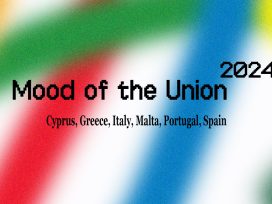
Europe’s weary shores
Cyprus, Greece, Italy, Malta, Portugal, Spain
Political instability, recession and environmental crises have contributed to the rising swell of social discontent in Europe’s south. But there is one issue more than any other being capitalised on by the Mediterranean’s resurgent far-right: migration.
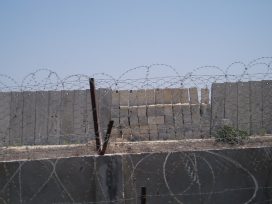
Do the violence and oppression against Palestinians in Gaza and the discrimination and surveillance against migrants trying to cross European borders have more in common than meets the eye? A Belgian activist of the international Freedom Flotilla Coalition speaks out about the Israeli arms industry, institutionalized violence and human rights abuses.




